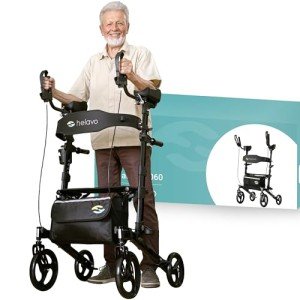A How-To Guide For Stable Walker From Beginning To End
Exploring the Innovations of Stable Walker Technology
In the ever-evolving world of robotics and automation, the idea of a “stable walker” has become a remarkable intersection of design, technology, and biomechanics. A stable walker describes a robotic system efficient in maintaining balance and traversing numerous surfaces, mimicing human-like motion. This blog site post offers a thorough expedition of stable walkers, their parts, applications, and the technological developments that continue to press the boundaries of what these devices can accomplish.
- * *
What Makes a Walker “Stable”?
At its core, stability in a robotic walker is defined by its capability to remain upright and navigate a variety of surface areas without falling. Numerous aspects add to a walker's stability:
- Center of Gravity: A lower center of gravity normally improves stability. Designers typically put components tactically to enhance this aspect.
- Sensing units: Advanced sensing units assist the walker detect changes in the environment, permitting real-time modifications to maintain balance.
- Actuators: These components make it possible for motion and play a vital function in consistent navigation.
- Algorithms: Sophisticated algorithms process sensing unit information and figure out the best movements, allowing adaptive walking.
- * *
Table 1: Key Components of Stable Walkers
Part
Function
Sensing units
Find ecological conditions and help in balance
Actuators
Propel motion in different directions
Control Systems
Integrate sensing unit input to make real-time balance adjustments
Power Supply
Provide necessary energy for functions and movement
- * *
Applications of Stable Walkers
The applications of stable walkers are huge and differed, covering numerous fields. Below are some essential locations where these innovations are making an impact:
Healthcare:
- Rehabilitation: Stable walkers can assist clients recovering from injuries or strokes by offering support while they restore their mobility.
- Exoskeletons: Wearable robotic devices can aid people with mobility problems, enabling them to walk again.
Search and Rescue Operations:
- Unmanned stable walkers can navigate hard surfaces during search operations after natural catastrophes. My Mobility Scooters are important in reaching areas that are unattainable to human beings or wheeled automobiles.
Elderly Assistance:
- Robotic walkers created for the elderly can help maintain self-reliance by offering support for motion and navigation around the home.
Industrial Applications:
- In settings where heavy loads require to be carried, stable walkers can help workers by bring products without the risk of losing balance.
- * *
Table 2: Applications of Stable Walkers
Application Area
Usage Case Description
Health care
Rehabilitation support and exoskeletons for mobility
Browse & & Rescue
Browsing disaster-struck locations for healing operations
Elderly Assistance
Supporting mobility for elderly individuals
Industrial
Bring heavy loads in complicated environments
- * *
Technological Advancements
Robotic walkers have advanced significantly over the past few years due to improvements in a number of crucial locations:
- Sensor Technology: Enhanced sensing units such as LiDAR, ultrasonic, and video cameras offer in-depth environmental mapping, allowing walkers to make more educated choices on the relocation.
- Artificial Intelligence (AI): AI and artificial intelligence algorithms help with much better prediction models for motion, enabling robotic walkers to learn from their experiences and enhance over time.
- Battery Life: The development of lighter, more effective battery innovations makes sure that stable walkers can operate longer with less regular recharging.
- Products Science: Innovations in products, such as lightweight composites, enhance the durability and performance of robotic walkers.
- * *
Difficulties Facing Stable Walkers
Regardless of the amazing advances in stable walker technology, various obstacles remain. A few of these include:
- Complex Environments: Navigating unpredictable surfaces is still a substantial difficulty for a lot of walkers.
- Expense and Accessibility: Many advanced robotic walkers are expensive, limiting their accessibility to a broader audience.
User Adaptation: Training users to successfully run or adjust to robotic walkers is crucial, especially in health care applications.
- *
Often Asked Questions (FAQ)
1. Can stable walkers be used outdoors?Yes, numerous stable walkers are created to operate in various outdoor conditions, with features to traverse uneven surface.
2. How do stable walkers differ from standard wheelchairs?Stable walkers supply active support, allowing for mobility and motion similar to walking, whereas wheelchairs provide seated assistance without enabling walking movement.
3. Are stable walkers safe for older grownups?Yes, they can substantially improve the security of older grownups by supplying stability and lowering the risk of falls. Nevertheless, users need to be trained on their correct use.
4. What is the future of stable walker technology?The future points towards more autonomous systems utilizing advanced AI, permitting walkers to make decisions in real-time and adjust to user choices and environments.
- * *
The exploration of stable walker technology reveals an amazing realm loaded with potential. These advanced machines blend engineering, expert system, and human-centered design to attend to important obstacles in mobility and ease of access. With ongoing advances set to more improve their capabilities, stable walkers represent a key innovation with the pledge to transform how people move and connect with their environments. Whether in medical facilities, catastrophe zones, or homes, the impact of stable walkers continues to grow, enriching lives and offering support in manner ins which were as soon as thought difficult.
As technologies progress and the combination of AI and effective materials continues, the future of stable walkers appears not only appealing however vital ahead of time human mobility and independence.
